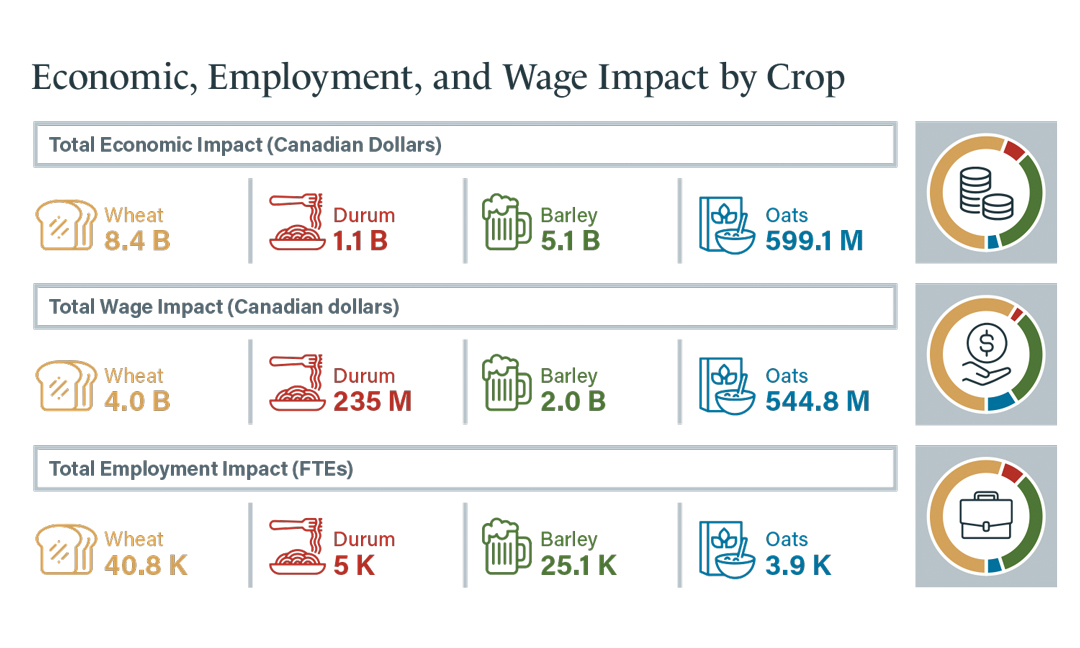CEREALS GENERATE BIG BOTTOM LINE
BY ELLEN PRUDEN • GRAPHIC COURTESY OF CEREALS CANADA
Alberta has long been known as an economic powerhouse when it comes to the energy sector, however a new report commissioned by Cereals Canada shines a light on another strong economic driver for the province and the country—cereal grains.
Data analytics company GlobalData recently undertook the study on behalf of Cereals Canada to assess the economic impact of domestically grown common wheat, durum, barley and oats on the Canadian economy. The project also produced seven provincial and regional reports, one of which focused on Alberta’s cereal sector.
Wheat and barley are the raw ingredients for two of the nation’s major agrifood industries—baking and brewing. In demand on the global market for their high quality, the two crops are also together exported to about 90 countries. Averaged over the past three years, the study found Canadian-grown cereals had an estimated total impact of $68.8 billion, and this included more than 372,000 Canadian jobs and $27 billion in wages. Most Canadian cereal production occurs in Western Canada, while much of the processing is carried out in Eastern Canada. Alberta’s grain sector was the third-largest contributor, after Saskatchewan and Ontario, accounting for $15.3 billion of the total economic impact, nearly 75,000 full-time equivalent jobs and $6.7 billion in total wage impact.
“Agriculture has consistently been an economic driver for the Canadian economy and the province of Alberta,” said Leif Carlson, director of market intelligence and trade policy with Cereals Canada. “When you break down the impact of Alberta-grown wheat, durum, barley and oats on the provincial economy, you can see the clear benefits of the cereals industry.”
Within Alberta’s agricultural sector, the two most economically important industries are cattle and grain. According to Statistics Canada, beef made up 30 per cent of farm cash receipts in 2022 while wheat, including durum, accounted for 15.3 per cent, and barley 2.7 per cent.
To calculate its figures, GlobalData also considered the economic activity generated through take-home spending by workers whose jobs support the production of the four cereal crops and the cereal supply chain. This includes work undertaken by engineers and tradespeople such as electricians, plumbers and pipefitters.
In addition to farming, which accounts for $7.9 billion of the sector’s total provincial economic impact, value-added activities such as processing make up $5.2 billion and logistics accounts for $2.1 billion. More acres of spring wheat are grown in Alberta than any other cereal, and it accounts for the lion’s share of the $15.2 billion total in this crop category. As the second-most seeded cereal crop, barley nonetheless packs a substantial economic punch of its own.
“As the leading barley producing province, Alberta contributes the largest shares of the economic impact of barley farming, malting and feed milling in Canada,” added Carlson. “The supporting processing industries really add a positive benefit and contribution to the economic success of Alberta.”
For more information on the contribution of Canadian wheat, barley, durum and oats to the Canadian economy, visit cerealscanada.ca/economic-impact.
Ellen Pruden is Cereals Canada director of communications.







Comments